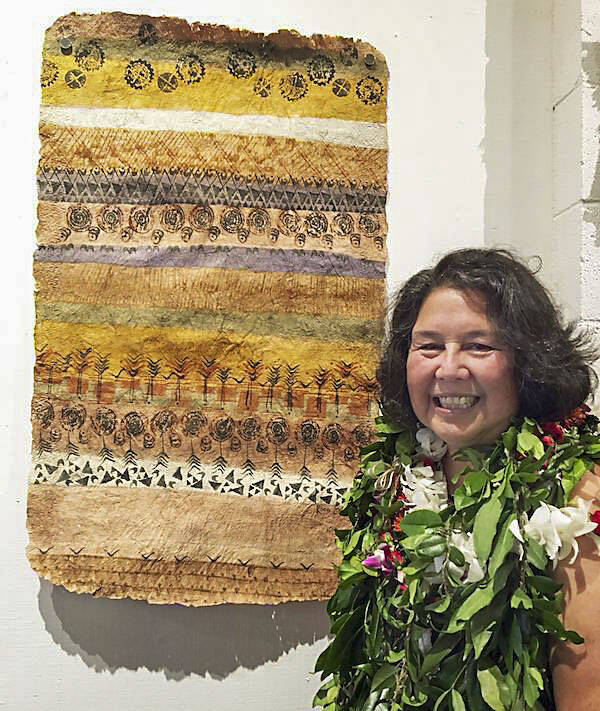Waimea’s Roan Hufford wins national honor

Photo by Lynn Martin Graton
Roan Kahalewai Hufford stands by one of her kapa creations.
A Big Island kapa artist was honored last weelk by a prestigious national fellowship in Washington, D.C.
A Big Island kapa artist was honored last weelk by a prestigious national fellowship in Washington, D.C.
Waimea resident Roan Kahalewai Hufford, 73, is sharing her passion and culture with the country as one of nine recipients of the 2023 National Endowment for the Arts National Heritage Fellowship, which is the nation’s highest honor in the folk and traditional arts.
Hufford has carried on the art of ka hana kapa, or making barkcloth, and is a leading figure in reclaiming the nearly lost Hawaiian art. She received the award after being nominated multiple times through the National Endowment for the Arts’ website.
Kapa is made from wauke, which is the plant that provides the strong bast fibre. The first Polynesian settlers carried it to the Hawaiian Islands on canoes.
Barkcloth once swaddled newborns, served as clothing, was made into blankets, adorned sacred images, and was used to prepare burials.
Although the art was nearly lost, it was bolstered by the Hawaiian Renaissance in the 1960s to the 1980s.
Hufford and her mother, Marie Leilehua McDonald, became important participants in the perpetuation of kapa.
“When I moved to Hawaii Island in 1990, my mother encouraged me to learn lei making and kapa, even though I didn’t even want to at first,” Hufford said. “Sometimes, I can’t believe I’m the one who gets to do this, but it is such an honor to be around all these artists who carry on their culture and to accept the same award my mother did years ago.”
Hufford’s award comes 33 years after her mother was honored with the same fellowship for lei making.
In 1990, Hufford and her mother went all out to retrieve the skills of ka hana kapa. They planted patches of wauke and dye plants, studied museum collections, and collaborated with woodworkers to make the needed tools necessary for kapa.
With her mother’s passing in 2019, Hufford inherited the legacy and has continued to teach the tradition to the next generation. She hosts a weekly kapa hui at her farm, where students of all ages, backgrounds and skill levels come to learn and share with each other.
“The most important part of kapa for me is the ability to pass it down for generations to come, so it doesn’t become a lost art,” Hufford said. “My mom was my teacher, and now I have students of my own who have learned about kapa, learned about the dyes, and learned about the culture surrounding why Hawaiians began making this in the first place. ”
Making kapa is a labor-intensive process. After peeling and cleaning the bast from 7- to 10-foot stems of wauke, the fiber is soaked in sea water, beaten with wooden mallets into thin sheets, and then felted into larger pieces.
In Hawaii, delicate watermarks are imprinted by patterned beaters, and the dried kapa is decorated with natural colors derived from flowers, fruits, bark and soil. Dyes are applied with handmade stamps, brushes, bits of wood, and even leaf stems.
She is one of the few kapamakers in Hawaii with enough wauke to share, and provides wauke “starts” for others.
“One thing that is necessary for teaching kapa is also educating students on the importance of preserving natural resources,” Hufford said. “To pass it on, you have to encourage them to grow raw materials by taking care of the place we live, maintaining open water sources and understanding cycles of plants on our aina.”
While in Washington, D.C., last week during the weeklong ceremony, Hufford was able to give presentations about kapa and be part of a panel discussions with other Fellows about native art at the National Museum of the American Indian.
On Friday, Hufford, along with the other 2023 National Heritage Fellows, were officially presented their awards during a ceremony at the Library of Congress. Recipients from 2020, 2021 and 2022 also were honored, since there were no ceremonies through the COVID-19 pandemic.
“(The Fellows) have been able to have intensive conversations on how we preserve our craft with our work and how we preserve our heritage by passing on our knowledge to generations after,” Hufford said. “It is incredible being able to share my culture with so many. You can read about any Fellow, but to be able to hear them, see them or feel the things they make, it makes a difference for people.”
Hufford plans to follow in her mother’s footsteps and continue teaching others who are eager to learn and pass it on themselves.
“I think (my mother) had a plan. It was built into her, and the kapa experience will now continue with every generation,” Hufford said. “When my students really get it, when they have success, or their dyes are gorgeous, or they just feel they’ve accomplished something, I feel like I’m accomplishing something myself.”
For more information on all of the NEA National Heritage Fellows since 1982, visit arts.gov/honors/heritage/list.
Hufford also will be showing some of her kapa creations in the Hana No Ke Au Hou exhibit at the Wailoa Art Center in Hilo from Friday, Oct. 6, to Thursday, Oct. 26.
Email Kelsey Walling at kwalling@hawaiitribune-herald.com.


